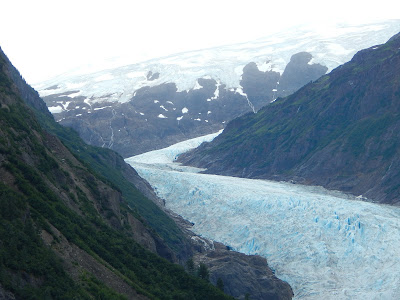A glimpse of the hard side of living and working in
Rancheria, Yukon , came from our waitress, Lois. She had black shoulder length hair with bangs.
“It takes me six hours to get hair
dye,” she said, referring to the drive between Rancheria and the next closest
store, three hours west. We all laughed,
“we” being the four tired and hungry female RVers from Washington state.
A ball of fire, Lois tried to keep us focused through our dinner orders,
switching between dodging our touristy questions, running up to the cash
register, showing new arrivals their motel rooms, bringing out food from the
kitchen and answering our bear questions.
“I am not afraid of bears,” she
said. “At my age, they know I’m not
going to hurt them and they can just sense it.”
Her age, in my mind, was a question.
She had the energy of a younger woman, like when she mentioned being
bucked off a horse and breaking her ankle last year. She also had the war
stories of someone who had wrangled tourists for many years.
“If you want to see bears, just go
down to the bridge,” she said, nodding in the direction from which we had just
driven. “You could come with me after I get off work. The old bridge washed out and it is full of
berries. Time and place,” she said, looking directly at us, “if you want to see
bears.”
 |
| Jerri, Lynn, Lynne and Sky with Torrie and Winnie in Yukon |
I pictured the end of her work day. It would still be daylight. On this day, the end of July, the sun set at 10:30 pm. We had driven four hours today, day six of our trip north. This afternoon we had emerged from the northern end of the
 |
| Fireweed |
Only one other site of the many available was occupied. We settled in adjacent sites. When three more RVs rolled in, they clustered near us, as if they also shared a bit of unease about the junkyard that edged one side of the campground, the unlabeled sites, and the isolation of it all. Each site had electricity--$20 a night for that and the use of the restroom. The TripAdvisor review had promised a nice walk along Rancheria River, but where was the river? In front of the small restroom building, four re-cycled toilets had been planted with cheerful purple petunias. The front door had been clawed by a bear. The recently swabbed down interior was a mirage of orderliness. The door dividing the women’s side from the men’s didn’t close. Neither warped stall door latched, leaving me with a sense of imminent exposure, had there been more people around. Each of the two dark shower stalls was equipped with a peeling chair resting on a wooden pallet. Still, we were looking for respite for the night, and this was it.
 |
| Wild Barley and Fireweed |
According to the guidebook, Yukon ’s total population: around 35,000. Two thirds of them live in the capital,Whitehorse .
I guessed that ten of the residents of Yukon
lived and made their living at Rancheria, perhaps fewer in the winter. The flannel
shirted young guy who pumped the propane was helpful and friendly, jiggling an
electrical circuit mounted to a telephone pole to get the pump working and
carrying the filled propane tank back to our campsite. Our friends had liked the skinny blond man
who ran the campground, although he seemed to disappear after we arrived.
I finally found the creek, after first heading down a likely looking path and encountering a big sign nailed to a tree: “Danger. Keep Out.” I made a second attempt in the company of two other travelers, Alaskans who had sold all their possessions and were heading to the lower 48 states to find their Shangri La, possibly inSouth Carolina . Just a few minutes walk past
purple fireweed, blue monkshood and pink flowering wild barley, the path opened
to a bend in Swift Creek with a broad flat rocky shore. My companions' dog raced to
fetch a ball while Winnie (our dog) waded into the creek and lapped up its cold
water. I reveled in the quiet, the sound
of rippling water, wind stirring the trees, and the undisturbed emptiness of
the forest across the creek from us.
Mobile users, here's a link: https://youtu.be/Vyenr8giur0
I finally found the creek, after first heading down a likely looking path and encountering a big sign nailed to a tree: “Danger. Keep Out.” I made a second attempt in the company of two other travelers, Alaskans who had sold all their possessions and were heading to the lower 48 states to find their Shangri La, possibly in
Mobile users, here's a link: https://youtu.be/Vyenr8giur0
